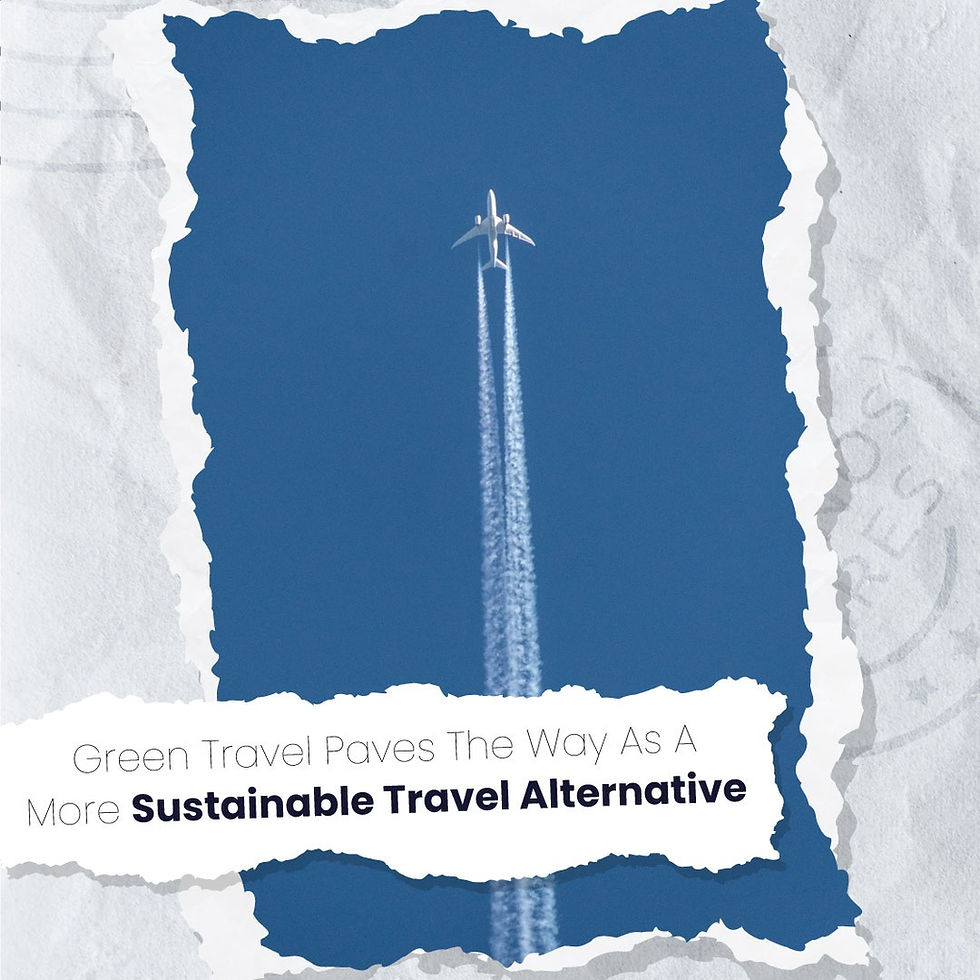Green Travel Paves The Way As A More Sustainable Travel Alternative
- Floating Lime

- Jan 22, 2022
- 4 min read

There is no doubt that almost every action we take today results in the release of greenhouse gases and impacts the climate crisis. From the food we eat to the clothes we wear, the products and practices that encompass our daily lives all contribute to impacting the global carbon footprint. Nevertheless, some actions have a greater influence on the climate crisis than others, particularly in the way that we travel and transport ourselves. On an overall scale, the transportation industry is accountable for approximately 5% of the global rise in temperatures. Though this may seem like a small figure, it is worth noting that only a very small percentage of the total population are frequent fliers, even when considering regular fliers from high-income nations. Per the estimations of the International Council on Clean Transportation (ICCT), a US-based non-profit, only 3% of the global population regularly utilize air travel. Yet, 2.4% of the world's CO2 emissions are derived from aviation. The ICCT further estimated that if everyone in the world took one long-haul flight per year, aircraft emissions would outweigh the CO2 emissions of the United States.
The continued popularity for air travel has made it one of the fastest growing sources of pollution and greenhouse gas emissions; one study shows that a return flight from London to San Francisco emits approximately 5.5 tonnes of CO2 equivalent per person, which is more than twice the emissions produced by a family car in a year and three times the emissions saved from a year of recycling. It is also not only the release of CO2 from flights that is critical to the environment; other substances such as soot and nitrous oxides as well as water in the form of contrails, are all capable of trapping additional heat at flight altitude. Consequently, the emissions from air travel have risen dramatically in the last decade and are projected to double in the next twenty years.
Travel and transportation heavily impact the climate crisis outside of the aviation sector as well. The combined effect of daily commutes, work travel and recreational trips are detrimental to the environment, accounting for 25% of the global energy usage. In fact, despite air travel being a significant source of emissions per passenger kilometer, short car trips are responsible for 75% of transport emissions. With so many people engaging in travel and so few of them willing to compromise on affordability and comfort, it seems like a challenge to find the means to travel while minimizing environmental impact. Travelling sustainably or green travel has become a prominent trend in eco-friendly living and a lifestyle choice for many; literally meaning to make more environmentally sound choices when travelling. Travelling green is a broad concept and is commonly distinguished as the implementation and adoption of responsible travel practices that consider social, economic and environmental sustainability. It does not ask the traveler to forgo the comforts of hotels or even eschewing travel altogether, but instead emphasizes on being mindful of the products and practices implemented before and during the trip.
Green travel is not only limited to the traveler’s destination or means of getting there; it also refers to eco-tourism, which involves responsible travel to natural areas, conserving the environment, and improving the well-being of the local people. It focuses on educating travelers on ecological conservation while amassing funds for economic development and political empowerment of local communities and cultures. It also intends to offer tourists insight into the human impacts on the environment and foster greater appreciation for natural habitats and ecosystems. Ecotourism is also supported by sustainable practices including recycling, water conservation and energy-efficient means when providing for locals. Green travel also enables travelers to deconstruct the carbon footprint of tourism; though transport is a heavy source of pollution, aspects such as lodging, food and drink, construction, all contribute towards the climate emergency. Taking all of this into account also enables travelers to understand which aspects to mindfully consider when minimizing climate impact during travel. As such, it has become an appealing topic of interest for many environmental advocates.
Travelling green is expected to begin prior to even travelling- it requires travelers to do their homework on the destinations that they are visiting and the modes of transport they are using. It emphasizes on packing light and bringing reusable alternatives instead of disposable ones, as well as suspending the electricity and heating from home when it is not being used. Green travel also focuses on choosing a mode of transport that minimizes environmental impact based on the distance and number of people travelling. Public transportation such as buses and trains are commonly recognized as emitting less pollution compared to air travel and rented vehicles. If these modes of transport are not feasible, travelling economy of flights or choosing energy-efficient planes are also perceived as more sustainable options. Additionally, green travel stresses on consistently using sustainable practices throughout the course of the trip. This means minimizing waste, shopping from local vendors, eating locally-produced food and making use of the public transportation system.
While these practices may seem like a challenge for some people, it is also necessary to understand that when our choices align with our eco-interests and values, living a greener lifestyle is no longer a sacrifice we are forced to make.
Sources








Comments